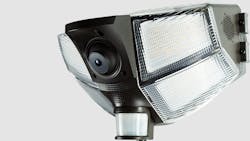AI-enabled camera stops dealership thieves in their tracks
With cargo theft on the rise and common powertrain controller theft still a risk, fleets are seeking new ways to protect their assets. One new technology solution for guarding parked assets is Nio, an AI-empowered camera whose company, iDter, claims can deter 98% of intrusions before any crime is committed—without the need for human intervention.
Imagine: A thief hops the fence to a commercial vehicle dealership after hours. As he creeps along the pavement, he is blasted with 10,000-lumen LEDs, red and blue flashing strobe lights, and is subjected to a 120-decibel alarm which can also play recorded audio of a voice saying the police are being called—and they are—all without needing human intervention.
“I think what’s really unique about it, it’s the combining of detection in seconds with immediate deterrence,” said iDter VP of Marketing and Business Development Greg Ayres.
Hence the company name, iDter, pronounced: “eye deter.”
See also: Machine learning predicts the future of driver safety
Truck dealerships are part of iDter’s clientele, and according to Ayres, utilize the technology to protect against theft of fuel and parts—the former due to historically high diesel prices, and the latter due to supply chain constraints inflating the value of certain components and materials.
Ayres said that traditional video surveillance systems are good for forensics, but although their presence can ward off would-be criminals, monitoring must be done by fallible human beings. Nio automates the process, alerting criminals that they are being surveilled, and notifying authorities if necessary. However, video feeds are still being monitored off-site.
“People are still involved in our process,” Ayres said, “but what we’ve done is we’ve reduced the amount of attention they have to pay to the system by 80%. So where it costs like $20 or $30 bucks per month to monitor a camera, we’ve got it down to three, four, or five dollars a camera.”
Nio uses motion detection in combination with video analytics for users to, at select times of day, cordon off certain areas as what Ayres called “no-fly zones.” Movement can be identified as either vehicles or people—with different responses programmed for each according to user preferences—using iDter’s cloud computing, and off-site security workers are notified.
See also: How eco-driving techniques can make a difference in truck driver safety
A team of approximately 30 off-site engineers train the AI by watching Nio alerts and tagging video data—such as whether the alert was justified or if the Nio AI correctly or incorrectly identified an intrusion.
Through a partnership with security company Noonlight, Nio units can automatically, if intruders do not retreat, notify police dispatch.
“It gets a higher level of alarm than you would if you went into your house and the alarm went off. Why? It’s a human-, video-verified alarm,” Ayres said.
Ayres characterized Nio as an all-in-one solution in which users don’t need to install separate alarms or lights. Additionally, there are two versions of the Nio: One runs off AC power and can be attached to, for example, a light pole. Another version uses power over ethernet, allowing installers to deliver electric current through an ethernet line so the camera can connect to the internet and power up with a single wire.
Jason Herrington, VP of operations at security system installer Rinkor Technology Solutions, is a Nio user who said it has “significantly cut down on the amount of foot traffic that’s unauthorized” and that it has protected the company fleet.
“Back in the early days, we had somebody that came in one time and they tried to tamper with one of the vans,” Herrington said. “He started tampering with it, and the iDter unit scared him off.”
The device can be configured via apps for the web or smart devices designed with a hierarchy of user access levels and configurable by the assigned system administrator.
About the Author
Scott Keith
Scott Keith is a former fleet owner digital editor, who was on staff from 2022 to 2023.



